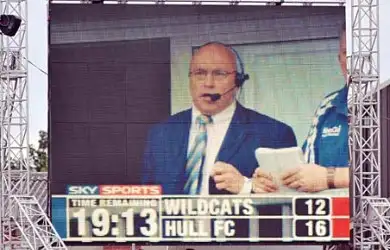Video Nasties…

I have to make one thing clear from the start of this article: I LOVED the World Cup. I was stirred by the Tongan sipi tau, I was enthralled the Fijian ‘I jiova’ and I devoured every single jaw-dropping, side-stepping, pancreas-lacerating moment of this tournament voraciously. If it was up to me, they really would carve the face of Joseph Paulo on Mount Rushmore!
But there’s just one thing that blighted this festival of sporting excellence for me: the dreaded and largely intrusive omnipresence of the video ref.
In truth, I’ve had grave concerns regarding this particular layer of officialdom for quite some time but RLWC2013 was, in my opinion, the nadir of the video referee. In an increasingly risk-averse world our merry whistle blowers (didn’t some bloke on the telly used to use that expression?) have seemingly decided to attempt to rule any slight element of doubt out of every single decision – regardless of the context. In doing so, however, they’ve compromised the very thing that ought to be the highpoint of each spectator’s viewing experience: the buzz of witnessing a try being scored.
There almost seemed to be a muted reception to lot of tries scored (or, as the case may be, not scored) during RLWC2013, a pregnant pause borne out of the expectation that the ref would halt the celebration by drawing a ‘square in the air.’
My personal ‘face palm’ moment came at Headingley when, with his side trailing 40-0 against the might of the Kiwis, Dion Aiye sent the South Stand into rapture with an improbable and audacious try for Papua New Guinea. Almost immediately though, the cork was quickly jammed back into the bottle, with the officials seemingly determined to find something (anything!!!) wrong in the build-up and with the technical means at their disposal to do so. Even though the try was eventually (one almost suspects grudgingly) given, with time enough for some thirsty punters to pop to the bar in the meantime, something of the initial magic of the moment had gone.
There are those, of course, who labour under the belief that this forensic analysis, replete with suitably atmospheric musical accompaniment, somehow adds to the sense of ‘theatre.’ There are others, meanwhile, who insist that, with so much at stake, it’s essential to seek cast-iron proof of the validity of every single decision. They’re both wrong!
For one thing, even from my distant vantage point in Row Z, I reckon that in around 95% of cases at the 16 games I attended my first instinct with a (very distant) naked eye ended up corresponding with the decision eventually reached by the video ref. Not the most scientific argument I’ll admit, but it does fuel my personal belief that in most cases the man in the middle – aided by his increasingly redundant ‘touchies’ – is often the best placed person to adjudicate on 50-50 calls.
Moreover, in some cases – particularly those involving the obstruction rule – the only possible way to determine the legality of a try is to view it in real time. Anyone who’s played rugby league at even the most modest level will know that when you run a wedge/A-Ball/Aussie play, which is still the staple of most passages of attacking rugby, there really is only a hair’s breadth between decoy/deception and obstruction. The whole thing is ultimately a matter of interpretation mixed with a degree of guesswork and slowing things down frame by frame can often be misleading.
Whether it’s fuelled by the desperation to earn a high profile booking for a showpiece game or simply a fear of incurring the wrath of disgruntled coaches, it’s clear that our officials are frightened to death of making mistakes. The first big irony, however, is that even after viewing each vignette of action from multiple angles mistakes are still made; no matter how many times certain tries (or No Tries, as the case may be) are viewed through frame after torturous frame, it’s still impossible to arrive at a conclusive decision.
I’m actually watching the last minute of Scotland’s titanic battle with Tonga again for the umpteenth time as I type this article and I’m still none the wiser as to whether Daniel Foster scores a legitimate try to win the game for the islanders. We’d be better sparing the cost of all this technology and flipping a coin!
The second major flaw in the decision to allow the game to become a slave to technology and officialdom is that people attend sporting fixtures partly out of a collective desire to share that euphoric moment when the ball hits the back of the net or the bails are displaced by a fast-paced delivery. The Barbour jacket brigade at Twickenham will happily endure 80 minutes of turgid rugby just on the off chance of witnessing one moment of brilliance or even a Jonny Wilkinson drop goal! Yet every time our officials choose to doubt their own judgement and set in motion an interminable array of video replays, they’re robbing our paying audience of that ‘moment.’
The final irony is this: whether or not a video ref has painstakingly sucked the life out of each 50-50 call there are still going to be contentious decisions. But surely these very talking points are the life blood of sport, aren’t they?